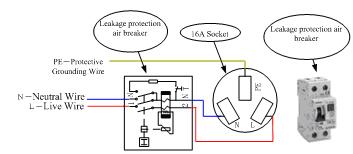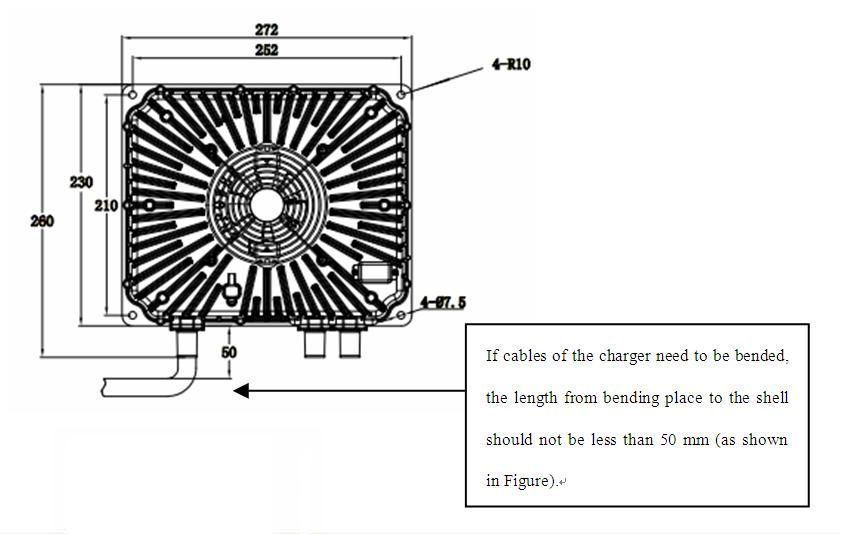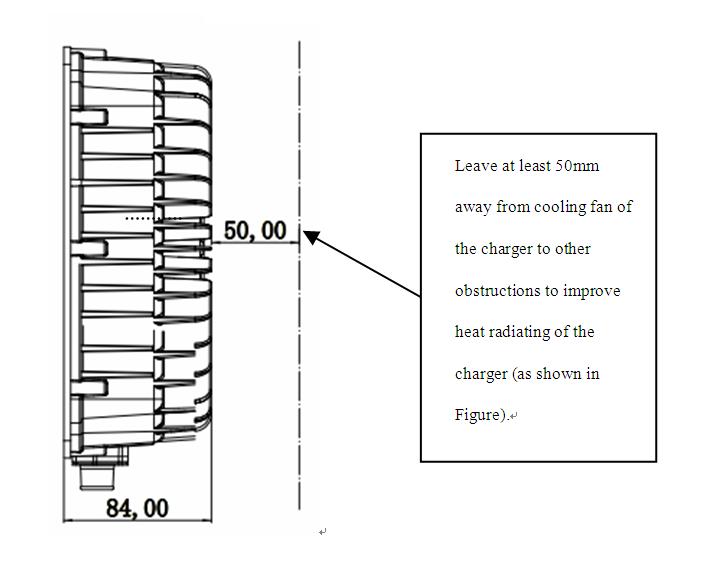|
3.3kw high efficiency intelligent charger is designed to charge power batteries of electric vehicles. This series of products adopt the most advanced technologies such as LLC resonant, active power factor correction, microcomputer measurement and control, digital adjusting, fully sealed waterproof technology and so on. Its features include: wide input voltage range adapted to global general voltage; High input power factor that significantly reduces the input current as well as heat generated by input cables, so the charger can be safely used in family; Low harmonic current that reduces interference to other electric equipment. Full range soft switching is realized to achieve high conversion efficiency and slight electromagnetic interference, the charger is more energy-saving and money-saving to use; the charger is designed according to IP66 protection grade and achieved high waterproof performance. Another feature includes small size, light weight, quiet operation, beautiful appearance, simple installation, operation and maintenance and so on.
The charger adopts microcomputer measurement and control technology, embedded CPU can accurately detect various states of battery. Advanced multi-stage charging mode can prevent the battery from be over-charged and over-discharged, minimize overheating and water loss phenomenon caused by over-charge, slow down polar plate vulcanization phenomenon caused by over-discharge, extend the service life of batteries. The charger will stop automatically after fully charged.
The charger has functions of temperature compensation, automatically shut down after fully charged, battery reverse connection protection, output short circuit protection, AC input under-voltage protection, overheating protection and so on, and these functions can ensure safe and reliable use.
II Safety Instructions
Please read these instructions carefully before you use the charger:
(1) For safety consideration, the charger adopts AC single-phase three-wire inputs which contain live, neutral and protective grounding wire. The shell of charger connects protective grounding wire. When using the charger, you should connect it to power grid with a quantified 16A three-hole socket which contains a grounding pole and controlled by a leakage protection air breaker with leakage protection function to prevent leakage and fire.
(2) Please use dedicated 16A plug and socket of reliable quality for the charger (Socket requirements: flame-retardant shell and cables of the socket, thick internal springs that not less than 0.8mm and has a good elasticity), or it may burn the plug and socket, even cause severe fire! Copper core cables thicker than GB 2.5mm2 are suggested to be used as power connections to prevent the cables from becoming too hot when charging ,so to prevent fires.
(3) Please do not disassemble the charger; this may cause electric shock or other injuries.
(4) If the charger need to be connected to AC power supply with extension cables, please make sure that the extension cable can withstand the maximum input current(GB 2.5mm2 copper core cable is recommended to be used), and limit the extension cable length within 10m.
(5) Don’t place the charger in water or rain position; otherwise there is a danger that may cause electric shock and damage to the charger.
(6) The charger’s DC output plug should be connected reliably to the socket, if they are damaged or loose, please replace them immediately, otherwise it will cause overheating in the plug position, and even cause serious fire.
(7) If the charger product any abnormal sound or smell during working, please unplug the power plug immediately and contact the service department. Do not attempt to open the shell of charger, to prevent electric shock.
(8) Make sure that all air vents are unobstructed to prevent charger overheating. Do not place the charger near a heat source; the charger should be left enough space to ensure ventilation and use of connectors.
(9) Please disconnecting the charger's AC input power if you need to move it.
(10) Make sure that AC power supply voltage matches chargers’ input voltage. For inquiries, please contact your supplier or local power Supply Corporation.
(11) Battery voltage and the nominal voltage of the charger must be matched; otherwise it will damage the charger or batteries.
(12) Do not pull, twist or shake the cables to avoid damage to the charger’s cables and connection terminals. If the cable is worn, please replace it immediately.
III Preventing Leakage and Fire
1. Correct use of Breakers, Sockets and Cables

(1) Its required to use a leakage protection air breaker with leakage protection function.
(2) Its required to use reliable qualified 16A three-hole socket to connect the charger to AC power.
(3) Input cables of leakage protection air breaker is required to use copper core cables with flame-retardant jacket, the cables’ core diameter is not less than 2.5mm2.
(4) The cables between leakage protection air breaker and 16A socket are required to use copper core cables with flame-retardant sheath, the cables’ core diameter is not less than 2.5mm2.
(5) Prevent plugs, sockets from dripping or splashing.
Note: According to statistics, 80% fire accident caused by an electric car occurred during charging, main reasons for this are insufficient core diameter size of cables, poor quality plugs and sockets, poor contact of plugs and sockets, poor flame-retardant sheath or shells of breakers, plugs and sockets and so on.
2. Correct Use of Input Connections


(1) It’s required to use a dedicated 16A power plug for the charger;
(2) It’s required to use copper core cables with flame-retardant sheath; the cables’ core diameter is not less than 2.5mm2.
(3) Make sure that the plug is clean (no dirty) and no damage before charging.
3.Charging Environment Requirements
(1) Spacious and airy;
(2) No flammable materials; prohibited charging in warehouse.
(3) Keep away from valuables such as automobiles.
(4) Keep away from bedroom when charging at night.
(5)Prohibit placing the charging plugs, charging cables or charger itself on car cabs, plastics chairs and other inflammable objects.
IV Regularly Maintenance
(1) Check 16A sockets regularly, if the connection between the socket and the plug is loose or poor contacting, they should be firmly connected or replaced before the charger be used. The poor contact may result in overheating and burning of the plug and socket, and even cause a fire.
(2) Check the leakage protection air breaker regularly using the test button to ensure its protection function is valid.
(3) Make sure to use a dedicated input cable and plug for the charger.
(4) Make sure that there are no foreign matters between the charger’s shell and the cooling fan to avoid damage to the fan.
(5) Make sure that the appearance of battery is not ballooning; the battery is not overheating when charging.
IV Product Models
Available Product Models
48V35A, 72V30A,96V25A,144V20A,312V10A
V Technical Specifications
Rated input voltage: 220Vac 50/60Hz
Input voltage range: 85~265Vac (Note: When the Input voltage is lower than 185Vac, the output power will be limited to 1.5KW)
Input Current: ≤ 16A (Note: except models of “CH4100-9625”)
Power Factor: ≥ 0.99 @ 220Vac input, full power output;
Total Harmonic Current: ≤ 5% @ 220Vac input, full power output;
Nominal output voltage (Un): See Model Description
Maxim output voltage: 140%Un
Rated output current (Ir): See Model Description
Voltage regulation accuracy: ≤ 0.5%
Current regulation accuracy: ≤ 2%
Conversion efficiency: ≥ 95% @ 220Vac input, full power output
Protection class: IP66
Audible Noise: ≤ 40dB
Seismic rating: Designed according to IEC60335-2-29-2004-Part.21
Working temperature: -25~55℃ (Note: models whose output power greater than 2KW will ensure 2KW output at 60℃. )
Storage temperature: - 40~80℃
Recognition certificates: CE SGS
VI parts list

A AC input Cables B DC output cables C Signal Cables
D Charging indicator E Mounting plate F Shell
G Cooling fan and fan cover
VII Input and output interface
|
Input Cables
|
|
Terminal Model
|
DJ7031-4.8-11
|

Direction of view: form the cables to terminal.
|
|
Terminal Model for matching
|
DJ7031-4.8-21
|

|
|
Needle No.
|
Wire Color
|
Wire core diameter
|
Description
|
|
1#
|
brown
|
2.5 mm2
|
L——Live wire
|
|
2#
|
blue
|
2.5 mm2
|
N——Neutral wire
|
|
3#
|
Yellow and green
|
2.5 mm2
|
PE——Protective grounding wire
|
Output Cables
|
|
Terminal Model
|
SB50
|

|
|
Needle No.
|
Wire Color
|
Wire core diameter
|
Description
|
|
+
|
red
|
6 mm2
|
Output positive pole
|
|
-
|
black
|
6 mm2
|
Output negative pole
|
|
Signal Cables
|
|
Needle No.
|
Wire Color
|
Wire core diameter
|
Description
|
Needle No.
|
|
1#
|
brown
|
|
|
|
|
2#
|
Blue
|
DJ7031Y-2.3-21
|
external LED indicator interface
|
DJ7031Y-2.3-11
|
|
3#
|
yellow
|
|
|
|
|
4#
|
purple
|
DJ7021-1.5-21
|
Battery Temperature sensor interface
|
DJ7021-1.5-11
|
|
5#
|
white
|
|
6#
|
pink
|
DJ7043-2-21
|
Serial communication
interface
|
DJ7043-2-11
|
|
7#
|
Yellow and green
|
|
8#
|
Blue and white
|
|
9#
|
Green and white
|
|
10#
|
orange
|
DJ7021-2-11
|
Forbidden signal interface
(normal close)
|
DJ7021-2-21
|
|
11#
|
grey
|
|
Wire core diameter
|
0.5 mm2 for all Signal wires
|
|
Signal Cables Terminal Diagram
|
|

Direction of view: form the cables to terminal.
|
|

|
|
|
|
|
|
|
|
|
|
|
|
|
|
|
|
|
|
VIII Charging Indicator Information Description
The charger installed a LED indicator internally, this built-in indicator display information through the window on the shell of charger. Besides the charger provides an external LED indicator interface that can connect the optional external LED indicator. Internal and external LED indicator can light synchronously with "red, green, yellow" three colors; the LED indicator can express a variety of working conditions of the charger with different color combinations. The following table is a description of indicator information.
|
LED Indicator Information Description
|
|
I. Charging Process Information
|
|
1
|
Low battery power
|
R---
|
|
2
|
Battery charge lower than 80%
|
R-
|
|
3
|
Battery charge between 80%--90%
|
Y-
|
|
4
|
Battery charge between 90%--100%
|
G-
|
|
5
|
Full charge
|
Normal process of charging
|
continuous Green light
|
|
Battery temperature sensor fault
|
Green light (3S) Yellow light (0.3s)
|
|
II. Alarm Information
|
|
1
|
Battery Not connected
|
R-G---
|
|
2
|
Charger over-temperature protection
|
R-G-Y---
|
|
3
|
Input fault protection
|
R-G-Y-Y---
|
|
4
|
Charging timeout
|
R-G-Y-Y-Y---
|
|
5
|
Battery Overheating
|
R-G-Y-Y-Y-Y---
|
|
6
|
Pre-Charge timeout
|
R-G-Y-Y-Y-Y-Y---
|
|
7
|
Internal temperature sensor fault
|
R-G-Y-Y-Y-Y-Y-Y---
|
|
8
|
Output voltage feedback fault
|
R-G-Y-Y-Y-Y-Y-Y -Y---
|
|
9
|
Low temperature start delay
(When the internal temperature of charger is between -20 to -30 ° C, the charger will delay starting for 1~2 minutes)
|
R-G-Y-Y -Y-Y-Y-Y-Y-Y---
|
|
Note:
1."-" represents led that does not light for 0.5s, a color word represents that the LED of this color lights for 0.2s.
2. R --red G —green Y—yellow
|
(1) Connect the output terminal of the charger to the battery terminal
(2) Connect the input plug of the charger to AC power socket until the charger turns into normal charging process (observe the LED Indicator), then Charger will automatically charge the batteries. When fully charged, the charger will automatically shut down, and display ‘full power’.
(3) If observed the battery become overheating or ballooning during charging process, you should stop the charger immediately by unplug the plug from the AC socket.
X Appearance and Installation Dimensions


XI Faults & solutions
If your charger can not work correctly, you can refer to table below
|
Fault Phenomenon
|
Analysis
|
Solutions
|
|
Battery temperature
Sensor Fault
|
External battery temperature sensor is fault or not connected
|
Check sensor connection or change a new one
|
|
Battery not connected
|
Battery is not connected or reverse connected
|
Check and connect the battery correctly
|
|
Over-temperature
protection
|
Charging environment temperature is too high; cooling fan is fault;
air vents are obstructed
|
Place the charger in lower temperature environments and recharge;
Check whether cooling fan is fault or air vents are obstructed
|
|
Input fault protection
|
Poor contact of charger’s input side ; Charger is broken
|
If no poor contact phenomenon occurs, please contact us
|
|
Charging timeout
|
Battery is damaged or aging
|
Check and replace battery
|
|
Battery Overheating
|
Battery is damaged or aging
|
Check and replace battery
|
|
Pre-charge timeout
|
Battery is damaged or aging
|
Check and replace battery
|
|
Internal temperature
sensor fault
|
Charger is broken inside
|
Please contact us
|
|
Output voltage
feedback fault
|
Charger is broken inside
|
Please contact us
|
|
“Full Power ”after
short charging
|
Battery is broken;
Poor contact between charger and battery;
Battery has been fully charged;
|
Check whether the battery is damaged; battery connecting cables are firm ; the battery is fully charged
|
|
Battery temperature becomes more than 50℃ and produces a lot of bubbles
|
Battery is aging ;
Battery voltage is lower than the nominal voltage of the charger
|
Check the battery, and replace bad battery; Reselect charger that match battery voltage level .
|
|
Low battery capacity after fully charging
|
Battery is aging
|
Replace the battery
|
|
Cables are too long or too thin Between the charger and battery
|
resume The output cables back to initial state
|
|
Charging time becomes too short or too long
|
Battery is aging
|
Replace the battery
|
|
Charger overheating protection
|
Check if there are foreign matters around the fan and remove them
|
|
Check whether the cooling fan is working correctly, or contact us to replace the fan.
|
|
LED indicator lights but no charging
|
Connectors are not connected firmly, or the polarity is reversed; Battery is disconnected
|
Connect all connectors correctly and recharge
|
|
Battery is broken
|
Replace new battery
|
|
LED indicator doesn’t light
|
AC input is not connected firmly
|
Check AC power supply and chargers’ input cables
|
|
Charger is broken inside
|
Please contact us
|
If your charger still cannot work correctly after above treatment, please record the state of the fault phenomenon and charging indicator information, then contact us.
|